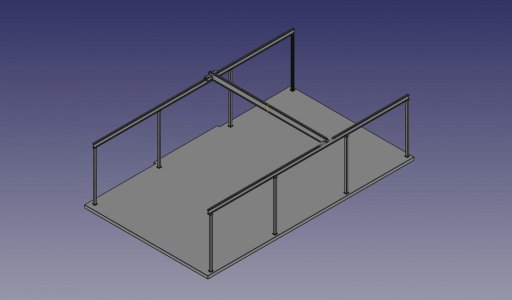View attachment 441217
I'm convalescing after my recent adventures, but thinking about this crane some more.
If you look at the image, it is almost intuitive that this structure needs some cross bracing. I intended from the start to incorporate such, sometimes pounding things into FREECAD just isn't worth the effort. I want to include what is a classic Y or trident bracing at the top of each post. There is also an assembly issue. The posts are currently free standing pillars. So the simple approach is to hoist each rail into position, bolt it to the top of the posts, then install the crossbracing, and the bridge beam. Each rail is about 500 lbs. And the bridge is about 500 lbs. Working on hoisting these into place while other pieces are suspended somewhat haphazardly overhead is, uh, stupid? So I need to come up with plan to do this methodically.
The catch is I'd like to have the structure somewhat less than rigid so that once everything is initially bolted together loosely, I can level the entire structure, probably using the same machinist level that I use to level lathe beds. And square it (rails parallel), etc.
Occurred to me that if I use a couple of l
arge turnbuckles, I can use those in place of a few of the Y post braces to achieve this, reasonably secure for assembly and adjustable until I square, level, grout and torque everything down. Now 16 of those gets to be pricey, but I can replace turnbuckles with fixed braces (basically a piece of say 1/2" x 1" flat HRS) bolted to the turnbuckle attachment points, and get away with quite a few less. Do I need those braces at every intersection? Well, probably not. I do intend to eventually go with a full height X brace in one place under each rail. But I'm not a steelworker, so I won't be welding/drilling bolt tabs into the structure after it is assembled. I'm just going to throw in more brace attachment points than I strictly need so that I have some options. So I need to go fab up a bunch of bolt tabs to weld on. That is just a single cut on the horizontal bandsaw, a drilling op, and cleanup on the belt grinder for each tab. 32 of them, coming up. Just as soon as I'm finished with post-hospitalization bed rest.


